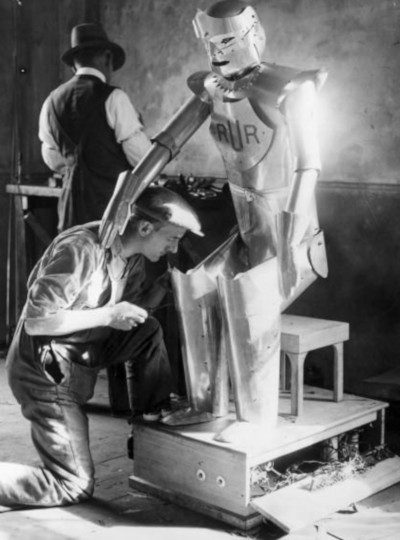A Centennial of Robots: From Mad Science to Our Reality

Karel Čapek’s R.U.R (1920) is perhaps best known for bringing the word robot into the English lexicon. According to Howard Markel, the word “comes from an Old Church Slavonic word, rabota, which means servitude of forced labor,” and various sources credit Čapek’s brother and regular collaborator Josef Čapek as the coiner of the word.[1] Since the play’s inception, the concept of robots has become a major force in both entertainment and scientific research, although, as scholars such as James D. Naughton and Sue Gee note, Čapek’s robots are remarkably different from the metal automatons contemporary audiences commonly associate with the word. They are described as being made of organic materials more similar to the replicants of Blade Runner or Cylons from Battlestar Galactica (2004), rather than technological androids such as C-3PO, Robbie the Robot, or Data from Star Trek.[2]
As cultural touchstones, R.U.R and its author enjoy a certain immortality via allusions and invocations in various arenas. One of the AI programs within Amazon’s Echo home assistants, one of 3 programs used to allow the machines to hold conversations, is named Alquist – the name of a critical member of the R.U.R. team in Čapek’s play. Eric, the first robot constructed in England in 1928, had R.U.R emblazoned across its chest. And numerous science fiction texts have references to or plots inspired by R.U.R. For example, the Star Trek episode “Requiem for Methuselah”(1969) features an android named Rayna Kapec, an anagram of Capek; in the cartoon series Futurama the planet Chapek 9 in the episode “Fear of a Bot Planet” (1999) is depicted as being inhabited by robots obsessed with killing all humans; and in Batman: The Animated Series, a character
named Karl Rossum is obsessed with replacing humans with machines (1992).
As the old adage “The more things change, the more they stay the same”[3] teaches us, as real world robot technology advances we are left still discussing many of the questions put forth by Čapek. With robots becoming more like living beings both in design and function, how are we to deal with them from legal and ethical stances? Questions such as these drive the research and scholarship of Dr. Kate Darling, an expert in robot-human interactions. As she says in her 2012 essay “Extending Legal Protection to Social Robots,” “The Kantian philosophical argument for preventing cruelty to animals is that our actions towards non-humans reflect our morality — if we treat animals in inhumane ways, we become inhumane persons.62 This logically extends to the treatment of robotic companions.”[4] And while growing fears over more and more labor being done by robots we are forced to consider how we will approach these issues.
[1] Markel, Howard. “Science Diction: The Origin Of The Word ‘Robot.’” Interviewed by Ira Flatow. Talk of the Nation 22 April 2011 NPR.com
[2] Naughton, James D. “Futurology and Robots: Karel Čapek’s R.U.R.” Renaissance and Modern Studies, vol. 28, no, 1 (1984), pp. 72-86; Gee, Sue. “The Word Robot Invented 100 Years Ago.” IProgrammer 26 January 2020.
[3] “plus ça change, plus c’est la même chose” –Jean-Baptiste Alphonse Karr, Les Guêpes, January 1849.
[4] Darling, Kate, Extending Legal Protection to Social Robots: The Effects of Anthropomorphism, Empathy, and Violent Behavior Towards Robotic Objects (April 23, 2012). Robot Law, Calo, Froomkin, Kerr eds., Edward Elgar 2016, We Robot Conference 2012, University of Miami , Available at SSRN: https://ssrn.com/abstract=2044797 or http://dx.doi.org/10.2139/ssrn.2044797